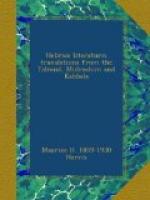Eiruvin, fol. 53, col. 2, and fol. 54, col. 1.
In continuation of the above we read that Shemuel said to Rav Yehudah, “Shrewd fellow, open thy mouth when thou readest, etc., so that thy reading may remain and thy life may be lengthened; as it is written in Prov. iv. 22, ’For they are life unto those that find them;’ read not, ‘that find them,’ but read, ’that bring them forth by the mouth,’ i.e., that read them aloud.” It was and is still a common custom in the East to study aloud.
As an anathema enters all the two hundred and forty-eight members of the body, so does it issue from them all. Of the entering-in of the anathema it is written (Josh. vi. 17), “And the city shall be accursed;” by Gematria amounting to two hundred and forty-eight. Of the coming-out of the anathema it is written (Hab. iii. 2), “In wrath remember mercy;” a transposition of the letters of the word for accursed, also amounting by Gematria to two hundred and forty-eight. Rabbi Joseph says, “Hang an anathema on the tail of a dog and he will still go on doing mischief.”
Moed Katon, fol. 17, col. 1.
The human body has two hundred and forty-eight members:—Thirty in the foot—that is, six in each toe—ten in the ankle, two in the thigh, five in the knee, one in the hip, three in the hip-ball, eleven ribs, thirty in the hand—that is, six in each finger—two in the fore-arm, two in the elbow, one in the upper arm, four in the shoulder. Thus we have one hundred and one on each side; to this add eighteen vertebrae in the spine, nine in the head, eight in the neck, six in the chest, and five in the loins.
Oholoth, chap. I, mish. 8.
See also Eiruvin, fol. 53, col. 2, and the Musaph for the second day of Pentecost. In the Musaph for the New Year there is a prayer that runs thus, “Oh, deign to hear the voice of those who glorify Thee with all their members, according to the number of the two hundred and forty-eight affirmative precepts. In this month they blow thirty sounds, according to the thirty members of the soles of their feet; the additional offerings of the day are ten, according to the ten in their ankles; they approach the altar twice, according to their two legs; five are called to the law, according to the five joints in their knees; they observe the appointed time to sound the cornet on the first day of the month, according to the one in their thigh; they sound the horn thrice, according to the three in their hips; lo! with the additional offering of the new moon they are eleven, according to their eleven ribs; they pour out the supplication with nine blessings, according to the muscles in their arms, and which contain thirty verses, according to the thirty in the palms of their hands; they daily repeat the prayer of eighteen blessings, according to the eighteen vertebrae in the spine; at the offering of the continual sacrifice they sound nine times, according to the nine muscles in their head,” etc., etc.
It is related of Rabbi Ishmael’s disciples that they dissected a low woman who had been condemned by the Government to be burned, and upon examination they found that her body contained two hundred and fifty-two members.




